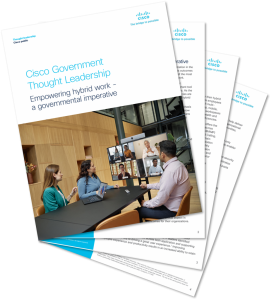Hybrid work is a flexible work model that combines in-office, remote, and on-the-go working. It provides the flexibility to be impactful wherever work is accomplished. However, while the term may be relatively new to many businesses and organizations, the foundational operational elements of hybrid work are not new to successful, high-performing organizations.
- Resiliency: The need to establish a resilient environment that ensures the business or mission continues to operate even in times of emergencies, where an emergency could range from an ice storm that closes roads and offices to catastrophic events that demolish buildings or critical infrastructure.
- Distributed: Based on availability and diversity to sustain essential functions, irrespective of where those functions are performed — in-office, remote, or mobile.
Continuity of Operations (COOP)
For those familiar with the words “Continuity of Operations,” it should be no surprise that the ability to agilely operate in a resilient environment to sustain continuity of critical operations is a national priority.
National continuity programs are based on the continuous performance of NEFs by sustaining essential functions performed by departments and agencies. Indeed, Presidential Policy Directive 40 (PPD-40) codified that “it is the policy of the United States to maintain a comprehensive and effective continuity capability through Continuity of Operations (COOP), Continuity of Government (COG), and Enduring Constitutional Government (ECG) programs, ensuring the resilience and preservation of government structure under the United States Constitution and the continuous performance of National Essential Functions (NEFs) under all conditions.”
The Federal Continuity Directive 1 (FCD-1) helps implement PDD-40 by establishing the framework, requirements, and processes to support the development of continuity programs and by specifying and defining elements of a continuity plan for federal executive branch departments and agencies. [1]
Continuity of operations is an effort within individual organizations (i.e., Federal executive branch departments and agencies) to ensure that Primary Mission Essential Functions (PMEFs) continue to be performed during a wide range of emergencies, including localized acts of nature, accidents, and technological or attack-related emergencies. FCD-1 outlines eleven Continuity Capability Elements[2] that are fundamental to a successful continuity program and that must be addressed in Continuity of Operations (COOP) plans.[3]
One critical element outlined in the directive is communications and information systems, specifically:
“the availability, diversity, and redundancy of critical communications and information systems are critical to sustain essential functions performed at primary and alternate locations including devolution locations as well as telework or mobile work environments. Communications and information systems provide the connectivity between and among key government leadership, internal elements, other organizations, and the public to perform essential functions. Telework and mobile work environments require use of portable telecommunications technology such as laptop computers, mobile telephones, and satellite communications equipment.” (Ref: FCD-1)
Read our white paper for insights on Hybrid Work for Government
Cisco Government Thought Leadership:
Empowering hybrid work – a governmental imperative
Also explore Cisco’s Hybrid Work Solutions for Government
Agile and Resilient
So why highlight multiple Federal government directives? Because the overarching logic is sound. Governments, companies, businesses and families need to build foundational resiliency to be able to operate in a crisis…whatever that crisis may be.
Having had the good fortune of working at Cisco for over 20 years, I’ve had the opportunity to experience the benefits of a hybrid environment personally. I worked at my mother’s house after her major surgery, at my husband’s bedside after an accident, and from my couch after my surgery. From an organizational perspective, as an AF Reservist assigned to the Pentagon, we operated thru 9/11. And at Cisco, we operated thru COVID without missing a beat.
The concepts are familiar, but the technology necessary to securely and agilely execute these concepts continues to rapidly evolve, providing an even more seamless and effective operational environment connecting organizations and individuals across the globe. And if your “standard way of doing business” is in an agile resilient context, then you, your organization, your business, and your country can survive and thrive in whatever life sends your way.
Hybrid work isn’t about being able to do laundry while attending a conference call. Hybrid work is about more effectively meeting operational requirements from an often distributed and agile environment whenever and wherever needed to continue mission operations.
[1] U.S. Department of Homeland Security, Federal Emergency Management Agency: Federal Continuity Directive 1 – Federal Executive Branch National Continuity Program and Requirements – PDF
[2] U.S. Department of Homeland Security: Federal Continuity Directive 1 (FCD 1) – PDF
[3] U.S. Department of Energy: Continuity Capability Elements (definition)


CONNECT WITH US